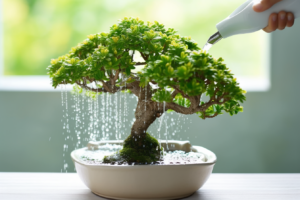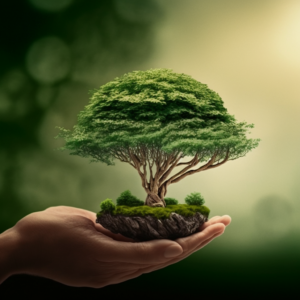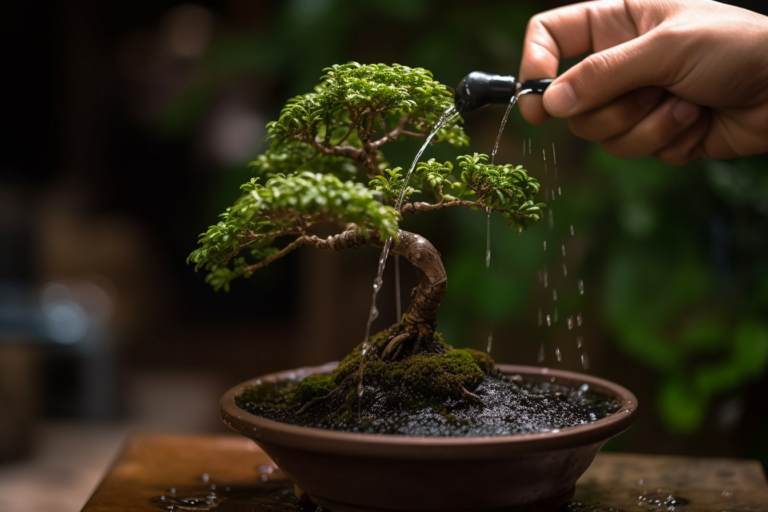So, you’ve finally decided to delve into the beautiful world of bonsai trees. Congratulations! However, a major concern for any bonsai enthusiast is how often to water these delicate plants. Worry not! We’re here to help you learn the ins and outs of bonsai watering.
The Importance of Watering Bonsai Trees
First, let’s understand why watering is crucial for bonsai trees. Watering provides essential nutrients and moisture that these small trees need to grow and stay healthy. Inadequate or improper watering can lead to under-watering or over-watering, causing damage or even the death of your bonsai tree.
Factors Affecting Bonsai Watering Frequency
There’s no one-size-fits-all answer to how often you should water your bonsai. Instead, various factors play a role in determining the watering frequency. Let’s examine them in detail.
Bonsai Species
Different bonsai species have different water requirements. For example, tropical bonsai trees generally require more frequent watering compared to temperate species. It’s important to understand your bonsai species’ specific needs.
Climate and Season
The climate and season significantly affect your bonsai’s water requirements. During hot and dry weather, you may need to water your bonsai more frequently, while cooler or humid conditions may necessitate less frequent watering.
Soil Mixture
The soil mixture plays a vital role in retaining water. Bonsai trees typically require well-draining soil, which allows water to pass through without causing root rot. However, this also means the soil dries out faster, requiring more frequent watering.
Pot Size
A smaller pot holds less soil and water, which means it dries out faster than a larger pot. As a result, bonsai trees in smaller pots will generally require more frequent watering.
Indoor vs. Outdoor Bonsai Watering
Indoor bonsai trees usually require less frequent watering than outdoor trees because of the more stable and controlled environment. However, they still need regular monitoring and appropriate care to ensure they receive enough water.
Watering Techniques for Bonsai Trees
There are two popular techniques to water your bonsai tree effectively. Both methods aim to ensure the soil is evenly moist without waterlogging.
The Soaking Method
The soaking method involves submerging the bonsai pot in a basin of water until the soil is thoroughly saturated. This technique helps to ensure that the entire root system is adequately watered.
- Fill a basin with water, enough to cover the soil surface of your bonsai pot.
- Place the bonsai pot in the basin, allowing the water to seep through the drainage holes.
- Keep the pot submerged until air bubbles stop appearing.
- Remove the pot and let it drain thoroughly.
The Shower Method
The shower method involves watering your bonsai tree from above, simulating natural rainfall. This technique is ideal for those who prefer watering their bonsai tree without removing it from its display location.
- Use a watering can with a fine nozzle or a hose with a gentle spray attachment.
- Shower the bonsai tree and its soil surface evenly until water starts to flow out of the drainage holes.
- Wait a few minutes, then water the bonsai again to ensure thorough saturation.
Signs of Over-Watering and Under-Watering
Recognizing the signs of over-watering and under-watering is essential for maintaining your bonsai tree’s health. Here are some indicators to watch out for:
- Over-Watering: Yellowing leaves, wilting despite moist soil, root rot, and mold growth.
- Under-Watering: Dry and brittle leaves, wilting despite dry soil, and slow growth.
How to Prevent Over-Watering and Under-Watering
To prevent over-watering and under-watering, follow these tips:
- Monitor the soil moisture regularly by touching the surface or using a moisture meter.
- Adjust your watering frequency based on factors like species, climate, and pot size.
- Use a well-draining soil mixture to prevent waterlogging.
- Ensure proper drainage by checking for clogged drainage holes.
Bonsai Watering Tools
Investing in the right tools can make bonsai watering easier and more effective. Some popular bonsai watering tools include:
- Watering cans with fine nozzles
- Hose attachments with gentle spray settings
- Moisture meters to monitor soil moisture
Additional Bonsai Care Tips
Besides watering, here are some additional tips to ensure your bonsai tree thrives:
- Provide adequate sunlight based on your bonsai species’ requirements.
- Fertilize regularly to replenish essential nutrients.
- Prune and shape your bonsai tree to maintain its miniature appearance.
- Repot your bonsai tree when needed to prevent root-bound conditions.
What is a Moisture Meter?
A moisture meter is a device that measures the amount of water in soil or other materials. These tools are useful for bonsai enthusiasts as they can help to determine the watering needs of a bonsai tree. A moisture meter consists of a probe that is inserted into the soil of the bonsai pot. The probe measures the amount of moisture in the soil and provides a reading on the moisture meter’s display.
How to Use a Moisture Meter for Bonsai Trees?
Using a moisture meter for bonsai trees is easy. Simply insert the probe of the moisture meter into the soil of the bonsai pot. Ensure that the probe reaches the depth of the root ball and not just the surface of the soil. Take note of the moisture level displayed on the moisture meter. Typically, a reading between 1 and 5 indicates that the soil is too dry and needs watering. A reading between 6 and 10 means that the soil is moist enough and does not require watering. Using moisture meters can help to prevent overwatering or underwatering your bonsai, ensuring that it remains healthy and thriving.
Advantages of Using Moisture Meters for Bonsai Trees
There are several advantages of using moisture meters for bonsai trees. Firstly, it helps to prevent overwatering or underwatering of the bonsai tree, which can be detrimental to its health. Secondly, it provides a more accurate measurement of the moisture level in the soil compared to using your finger to feel the soil’s moisture. Furthermore, moisture meters can help to save time and reduce the guesswork involved in determining the watering needs of your bonsai tree.
Disadvantages of Using Moisture Meters for Bonsai Trees
While moisture meters are beneficial, they do have some disadvantages. Firstly, moisture meters can be expensive and may not be a feasible option for beginner bonsai enthusiasts on a budget. Secondly, moisture meters may require different probes for different soil types, which can add to the cost. Finally, moisture meters need to be calibrated regularly to ensure that they provide an accurate reading.
In conclusion, using moisture meters can be an invaluable tool for bonsai enthusiasts to determine the watering needs of their trees accurately. While they do have some disadvantages, the benefits outweigh them. If you are serious about bonsai cultivation, investing in a moisture meter is worth considering.
When to Water Your Bonsai
Watering your bonsai is a crucial aspect of its growth and development. Over-watering or under-watering can be detrimental to the health of your bonsai plant. The timing of watering can vary based on several factors such as the season, location, and type of bonsai you have. Here are some tips for when to water your bonsai:

Observe the soil
The most effective way to determine if your bonsai needs watering is by observing the soil. Gently insert a wooden skewer or a chopstick into the soil up to the plant’s roots. If it comes out dry, it is time to water the plant. If it comes out moist, wait for a few days before checking it again.
Consider the climate
Climate can greatly affect how often you should water your bonsai. If you live in a hot and dry area, your bonsai will need more frequent watering compared to a more humid area. Similarly, if you live in a cooler area, you may need to water your bonsai less frequently.
Check the time of day
Watering your bonsai early in the morning or late in the afternoon is ideal. It gives enough time for the water to be absorbed without drying out the soil too quickly. Avoid watering your plant during the hottest hours of the day in order to prevent water from evaporating too quickly.
Adjust for the season
The watering frequency and amount needed for your bonsai may differ during the different seasons. During the warmer months, you may need to water more frequently, but during the colder months, you may need to water less. Once the weather starts to cool down, water your bonsai only when the soil begins to dry out.
Watch out for signs of under or over watering
Under-watered bonsais may display symptoms such as leaves turning brown and crispy, while over-watered plants may develop yellowing leaves and a mushy base. If you notice any of these signs, adjust the watering of your bonsai accordingly.
In conclusion, watering your bonsai is about finding the right balance. Observing the soil’s moisture level, considering the climate and time of day, adjusting for the season, and watching out for signs of under or over-watering can help maintain the health of your bonsai.
What Type of Water to Use for Bonsai
When it comes to watering our bonsai, it’s not just about the quantity and frequency of watering. The type of water we use is also important. Here are some things to consider when it comes to choosing the right water for your bonsai:
Tap water
Depending on where you live, the tap water may not be suitable for bonsai due to the presence of minerals and chemicals. Chlorine, fluoride, and high levels of salt can all be harmful to your plant. However, some tap water is safe to use, especially if it has been left to stand for a few hours to allow the chlorine to evaporate.
Rainwater
Rainwater is a great option for watering bonsai as it is naturally soft and free from the minerals and chemicals found in tap water. If you’re lucky enough to live in an area with regular rainfall, consider collecting rainwater to use for your plants.
Filtered water
Using filtered water is another option for watering bonsai. Filtered water can be obtained from a home filtration system or by using a simple carbon filter attached to your tap. This can remove any harmful chemicals and minerals, leaving you with clean and pure water for your bonsai.
Bottled water
Bottled water is a popular choice for many bonsai enthusiasts, but this can get expensive over time. Additionally, some bottled water may not be suitable for bonsai, as it can contain minerals and additives that can be harmful to your plant. Make sure to check the label before using bottled water for your bonsai.
In conclusion, the type of water we use for our bonsai is just as important as how much and how often we water them. Tap water can be suitable in some areas, but rainwater and filtered water are generally safer options. If you decide to use bottled water, be sure to check the label to ensure it is safe for your plant.
Dealing with Overwatered or Underwatered Bonsai
Overwatering or underwatering your bonsai tree can lead to some serious problems, including root rot, yellowing leaves, and even death. Here are some tips to help you deal with these issues and get your bonsai back to its healthy self:
- Signs of Overwatering: If you notice that the soil is constantly wet or there is standing water in the bottom of the pot, your bonsai tree is probably overwatered. The leaves may start turning yellow or brown, and the roots may develop a foul odor.
- How to Fix Overwatering: Start by removing the bonsai tree from its pot and examining the roots. Trim any rotting or black roots using sterilized scissors or shears. Repot the tree in fresh, well-draining soil and make sure to water it only when the soil is dry to the touch.
- Signs of Underwatering: When the soil becomes dusty or cracked, or the leaves become dry and crispy, your bonsai tree is probably underwatered. You may also notice that the leaves start to curl or wilt.
- How to Fix Underwatering: Water your bonsai tree thoroughly until the soil is saturated, then allow it to drain completely. Check the soil regularly and water as soon as it starts to feel dry.
- Preventing Future Issues: To prevent overwatering or underwatering in the future, make sure to water your bonsai tree thoroughly but not too frequently. The frequency of watering will depend on factors such as the species of the tree, the season, and the weather conditions. It’s also a good idea to use a well-draining soil mix and proper drainage in your bonsai pot.
By keeping a close eye on your bonsai tree and taking action quickly if you notice any signs of overwatering or underwatering, you can help ensure that your tree stays healthy and beautiful for years to come.
Tips for Maintaining Proper Bonsai Watering
Proper watering is one of the most important aspects of bonsai care. Here are some tips for maintaining optimal watering conditions for your bonsai:
- Determine the watering needs of your bonsai: Each bonsai species has its own specific watering needs. Some bonsai require more water, while others require less. It is essential to research and understand the watering requirements of your particular bonsai species.
- Water your bonsai regularly: It is important to water your bonsai frequently but not excessively. Most bonsai require frequent watering, especially during the summer months when the weather is hot and dry. During the winter months, you should reduce the frequency of watering to prevent overwatering.
- Use the right type of water: Use clean, fresh, room temperature water to avoid shocking the roots of the bonsai. Avoid using hard water or softened water, as both can cause adverse effects on the bonsai.
- Water your bonsai thoroughly: Water your bonsai thoroughly so that the entire root system gets wet. Avoid watering the foliage to prevent waterlogging and fungal growth.
- Check the soil moisture level: Before watering, check the soil moisture level by inserting a chopstick or a moisture meter into the soil. If the soil feels dry, it’s time to water the bonsai.
- Use a humidity tray: A humidity tray can help maintain the moisture level in the air around your bonsai. This will prevent the soil from drying out quickly, especially during the summer months when the air is hot and dry.
- Monitor your bonsai for signs of over or underwatering: Overwatering or underwatering can harm the bonsai. Signs of overwatering include yellowing of leaves, root rot, and a foul odor from the soil. Signs of underwatering include wilting leaves, brown and crispy edges, and slow growth.

By following these tips, you can ensure that your bonsai receives the proper amount of water and thrives. Remember, each bonsai is unique, and it’s essential to understand its specific watering requirements for optimal care.
Conclusion
In conclusion, understanding how often to water your bonsai tree is crucial for its health and longevity. Factors such as species, climate, soil mixture, and pot size all play a role in determining the watering frequency. By using proper watering techniques and monitoring your bonsai tree’s health, you can maintain a thriving and beautiful bonsai tree.
FAQs
How often should I water my bonsai tree?
There's no universal answer, as the frequency depends on factors like species, climate, soil mixture, and pot size. Monitor the soil moisture and adjust your watering schedule accordingly.
Can I over-water my bonsai tree?
Yes, over-watering can be harmful to your bonsai tree, causing issues such as root rot, mold growth, and yellowing leaves. To avoid over-watering, ensure proper drainage and monitor soil moisture levels regularly.
What are the signs of under-watering my bonsai tree?
Signs of under-watering include dry and brittle leaves, wilting despite dry soil, and slow growth. It's essential to adjust your watering schedule if you notice these signs.
Which watering technique is better for my bonsai tree: soaking or showering?
Both methods have their advantages. The soaking method ensures thorough saturation of the root system, while the shower method simulates natural rainfall. Choose the technique that works best for you and your bonsai tree.
How can I prevent over-watering and under-watering my bonsai tree?
Monitor the soil moisture regularly, use a well-draining soil mixture, ensure proper drainage, and adjust your watering frequency based on factors like species, climate, and pot size.

